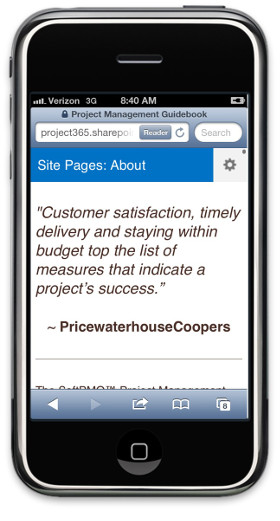4. The SoftPMO Toolkit and the Distributed Team Manager
What Does the Distributed Team Manager Need?
What is a “distributed team”?
A project has a “distributed team” when staff members are located in different buildings, cities, time zones, or countries where it may be difficult or impossible to work side by side on a regular basis.
Why is distributed team management so challenging?
One of the most important responsibilities of a project managers is to make sure all team members understand what they are supposed to do and why and when they are supposed to do it. To accomplish this the project manager and team members must communicate on a regular basis.

Many tools are available to help. Project manager can use meetings, phone and conference calls, audio and video chat, presentations, online chat and text messaging systems and of course, email, to support communication and collaboration among project team members.
As projects and teams increase in complexity and size, it also becomes more likely that team members will be located in different buildings, cities, time zones, or even different countries. This makes keeping everyone “on the same page” more difficult, especially when the following types of situations occur:
- There are many different viewpoints to consider.
- Team members have not worked with each other before.
- Messages communicated across teams are inconsistent or not well organized.
- Team members or stakeholders who have not been not involved in developing the project’s approach feel “out of the loop.”
- Change occurs so rapidly in project details that a danger exists that some team members will fall behind.
What do distributed teams need?
To combat these situations distributed teams need:
- Consistent communication about the project.
- Opportunities to collaborate and share information.
Consistent communication.
One important contributor to project success is good communication about team members’ roles and responsibilities. Making sure all team members are “on the same page” is one of the many responsibilities of the project manager. The more team members understand both what they need to do and how what they do interacts with others, the more likely the project will be a success. The project manager must ensure that all team members possess both a consistent picture of the project and a sense of ownership and responsibility for the project’s activities — and ultimate success.Collaboration and sharing.
Not only does the project manager need to makes sure that communication occurs effectively about project roles and responsibilities, people need to work together toward a common goal. They need to share information across teams and with executive management and project stakeholders. Barriers to sharing information caused by organizational rivalries, technological shortcomings, and bureaucratic wrangling need to be mitigated.Using the Toolkit to Promote Communication and Collaboration
The online version the SoftPMO Project Management Toolkit consists of the delivery, via SharePoint services, of the electronic versions of both the SoftPMO Project Management Guidebook and the SoftPMO Project Management Templates. Documents can be downloaded in .pdf format (Guidebook) or accessed as Microsoft Office files.
The benefit of using SharePoint for managing and accessing the Toolkit is that key project documents can be collaboratively developed and rapidly shared with any project team member with a SharePoint account. This means that:
- As long as they have SharePoint accounts, team members have immediate access to shared documents modified or created by the project manager and shared only with them.
- Changes made to a process template can be shared immediately and commented on by team members, without having to wait for the inefficiencies of emailed file attachments to circulate.
- Audio or video conference calls can take place to discuss, comment on, and revise a single version of a document, spreadsheet, or presentation.
- Microsoft Office and SharePoint automatically supports archiving and version control.
- When necessary, individual documents, including both the Guidebook and individual process templates, can be easily downloaded and printed.
By distributing a link to a SharePoint supplied SoftPMO process template, the project manager is assured
that team members will see, comment on, and discuss the same information, regardless of where they are located.
Using the Toolkit with a Distributed Team
SoftPMO process templates are not simple “copy and paste” documents. Using them as the basis for collaboratively developing or reporting on a single project or multiple projects requires the exercise of professional judgment.
Using the SoftPMO templates the project manager and team members generate a set of explicit statements about key project elements that can be discussed, reviewed, negotiated, and ultimately agreed to by the project’s team members, owners, and stakeholders. This simplifies communication, reduces the likelihood for disagreement, and facilitates progress reporting. It also provides the experienced project manager with assurance that the most important facts and figures about the project are providing the basis for reality based project decisionmaking.
Using the templates online or as downloaded documents make no assumptions about the features of specific systems or technologies that support the project management process or the Project Management Office (PMO). SoftPMO customers can use whatever project planning, project tracking, time reporting, or financial tracking practices their employer provides.
With the Toolkit, SoftPMO has done the “heavy lifting” of defining and organizing for the experienced project manager the most important elements required for project success. SoftPMO goes beyond Gantt charts and time reporting to ensure that all essential business and management requirements are addressed. This provides assurance that the most important elements of project management – and project success — are captured, visible, and available for attention by management and the project team.



